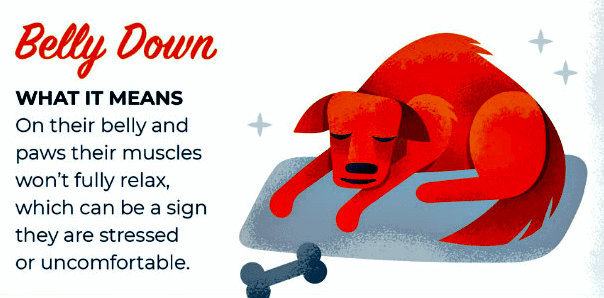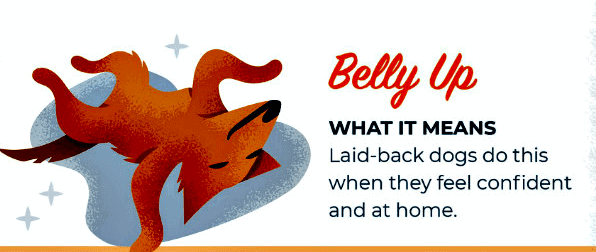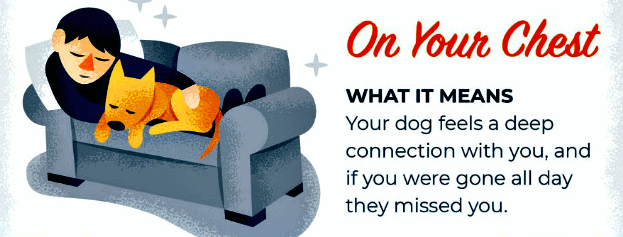
Watching your dog sleep can be comforting and sometimes comical, but your pup’s adorable dog sleep positions also tell you a lot about your dog and its sleep ability.
Several of your dog’s sleep behaviors are similar to those of humans, while others are inherent in all dogs.
Dog sleep positions meaning
- Dog sleep positions meaning
- Poor rest sleep position
- Dog sleep stages
- Should your dog sleep with you?
- Help dogs with anxiety or sleep disturbances rest
- Establish healthy sleep routines
- Create a comfortable sleep spot for your dog
- Help your dog get a good night's sleep
- Help dogs overcome sleep issues
- Health benefits of quality sleep for dogs
- Health risks of poor sleep
- Bottom line on dog sleep positions

Did you know your pup’s sleeping position can influence how well your dog sleeps?
Understanding your dog’s sleep position can give you insight into your dog’s personality.
The average adult dog needs 12-13 hours of sleep per day. It may not seem that way, but puppies snooze even more!
Adult dogs kept indoors sleep longer and deeper than working dogs or dogs kept outdoors. Because their situation is precarious, outdoor dogs rarely relax enough to reach a healthy, deep, restful sleep.
Instead, they rely on catching an extra nap here or there.
Consider providing a high-quality outdoor dog bed to help an outdoor dog get good rest.
Most dogs are skillful at catching a few winks whenever they can. Although they seem to fall asleep quickly, napping resembles Stage 1 sleep, where they barely sleep.
Poor rest sleep position

Curling up — the most common sleeping position — provides the highest security. Dogs curl in a ball, with their paws underneath and their tails wrapped around their faces.
The most common position is curling up, which is a favorite for dogs kept outdoors or suffering separation anxiety.
You often find a dog curled up in a ball. The dog sleeps with its paws tucked under its body and its tail wrapped around its face.
By covering their faces, dogs protect their eyes and throats. Although this is the least vulnerable sleep position, it is also the least restful way for dogs to sleep.
Although the position lets dogs conserve body heat and protect limbs, face, throat, and vital organs, dogs remain tense.
This position gives them the advantage of getting on their feet immediately. The dog’s muscles are tight and ready to spring into action. Dogs that sleep in this position rarely relax enough to drift into the REM stage.
Curling is the typical sleeping position for wild dogs and wolf packs. Upon awakening, this position gives the dog awareness because its senses are heightened to movements, sounds, and scents. The dogs conserve space in the den while protecting their offspring and sharing body heat.
Even most domesticated puppies inherently curl up together or around their mother.

This allows them to jump up at the slightest perceived threat or react quickly if they think they are missing out on your actions.
When dogs sleep with their head on top of their paws in the lion’s pose, they are lightly sleeping and ready to leap up if necessary.
Dogs that sleep on their backs with their paws “protecting” their chests indicate they prefer not to be bothered. Use caution when suddenly awakening any dog sleeping in this position.
If your dog’s crate is too small, he may not be able to get into his favorite sleep position. Find a crate that fits your dog’s size and temperament to ensure he sleeps well.
Restful sleep position

Dogs that sleep on their sides are comfortable in their surroundings.
If dogs lie on their side with their legs extended, they are comfortable in their surroundings.
A “super dog” sleeper chooses to sleep sprawled out on its stomach with its back legs stretched out behind, looking like it’s flying.
This position is also called the Superman position, and it looks like a dog sploot stretch.
Dogs in this position are in restful sleep but ready to go as soon as they hear you move.
Finally, we have the “dead roach” position, with the dog sleeping on its back with its legs extended in the air.
Only confident, secure indoor dogs choose this position because sleeping on their backs is the most vulnerable dog position.
It’s also the most comfortable and restful position. Puppies are more likely to sleep on their backs with the rest of their litter because they feel safe and secure.

Researchers have not observed dogs or wolves in the wild sleeping on their backs.
Dogs kept outdoors will not sleep in this position either because it sends a vulnerability and submission message.
Dog sleep stages
Dogs that sleep with their bellies and legs in the air are confident and comfortable in their surroundings.
It appears dogs follow similar sleep stages and sleeping habits as humans.
Dogs in Stage 1 are barely sleeping. This is the stage where most outdoor dogs, wild dogs, and working dogs sleep.
As they enter Stage 2, their blood pressure, heart rate, breathing, and body temperatures gradually lower.
When dogs transition between light and deep sleep, they’re in Stage 3.
At Stage 4, they enter the slow-wave stage, during which dogs are usually oblivious to their surroundings. If awakened suddenly, they often appear confused.
Stage 5 is where the fun and REM (Rapid Eye Movement) sleep phase begins. Dogs relax their bodies, but their brains remain active.
You can help ensure your dog gets a good night’s sleep by giving him CBD oil. This oil can help dogs relax and ease any pain that may keep them from sleeping.
Do dogs dream?

At Stage 5, the dog’s eyes roll under the lids, slowly easing into those amusing dreams.
They whimper, growl, make lapping and eating sounds and motions, whine, bark, and appear to be chasing something.
Some dogs will cycle their legs as if they are running. Others even wag their tails.
Most indoor dogs snuggle into their beds and spend up to 12% of their sleeping time in REM.
Puppies spend more time in REM, and most experts think that during this stage, puppies process and merge what they are learning daily into the behaviors they will follow.
Interestingly, smaller dogs tend to dream more than their larger cousins.
Some dogs shake while they sleep. While shaking can signify health problems such as hypothyroidism, pain, chills, and gastrointestinal discomfort, it’s typical behavior for most dogs.
Dogs that suffered trauma and puppies removed from their moms too soon may shake in their sleep.
If you observe your dog shaking while sleeping, calmly call his name and gently pet or touch him to reassure the dog that everything is OK. Do not shout or shake them awake.
It’s unclear whether dogs have nightmares, but given that many rescues and dogs that have suffered severe physical and emotional trauma shake in their sleep, a little assurance goes a long way.
 Should your dog sleep with you?
Should your dog sleep with you?
Nearly half of Americans’ dogs sleep in bed with their owners, and they tend to use several typical dog sleeping positions with their owners.
You may wonder why my dog sleeps on me, why does my dog sleep between my legs, why does my dog sleep touching me, or why my dog sleeps on me and not my husband?
Or why does my dog sleep on my pillow? Why does my dog sleep at my feet? Why does my dog sleep on top of me, or more annoyingly, why does my dog sleep on my head?
The answer is simple. Because dogs are social animals or pack animals, they naturally sleep while touching family members.
Snuggling up next to you is an innate pack instinct. Don’t be surprised if your dog wants to sleep between your legs or with his back pressed against yours. That’s a sign your furry companion sees you as part of their pack.
If your dog doesn’t touch you while sleeping, he’ll likely want to sleep on your side of the bed to soak up your scent.
Some dogs will sleep curled up in a ball next to you, and some will sleep with their back to you, facing away so they can alert you to any potential dangers. Pack members protect each other.
That’s also why some dogs sleep at the foot of the bed or position themselves to face the door. Your dog takes protecting you seriously and knows you are most vulnerable while sleeping.
Other dogs prefer having their own space.
Some like to sleep in their crates, and others prefer to sleep in a bed of their own, whether it’s a flat circle with edges for resting their head or a sleeping bag that creates a safe, cozy spot.
Invest in a comfortable bed or blanket to ensure your dog gets a good night’s sleep.
Best dogs to sleep with

Any breed can be an excellent sleep companion. It all depends on how much space you both need.
How your dog sleeps with you will determine how much rest you both get. Sleeping with dogs provides plenty of benefits for dog owners.
Not only does it reduce stress, but it also makes you feel safer. A study from Canisius College in Buffalo, New York, shows women feel safer and sleep better with dogs in their beds.
The research shows women feel more secure and sleep better with a dog than with a man. The study shows both men and cats were more likely to disrupt a woman’s sleep.
Should you pet a sleeping dog? Petting dogs when they are sleeping can disrupt their sleep.
Generally, avoid touching a sleeping dog unless it is whimpering or shaking. In that instance, a gentle pat can help soothe the dog.
If you pet a dog and it falls asleep, you can stop or continue stroking it.
Help dogs with anxiety or sleep disturbances rest
Dogs can experience anxiety and have trouble sleeping.
As a pet owner, it’s essential to understand the signs of anxiety and sleep disturbances to help your dog get the rest he needs for optimal health.
Anxiety warning signs include panting, whining, or trembling. When left alone, dogs may also display destructive behavior, such as chewing on objects or scratching doors and windows.
Sleep disturbances can manifest as frequent waking up throughout the night, restless tossing and turning, or difficulty falling asleep.
Stressors like changes in routine or loud noises can trigger underlying medical conditions such as arthritis or neurological disorders.

Establish healthy sleep routines
Understand the natural sleeping patterns of dogs to establish a healthy sleep routine.
On average, adult dogs need about 12-14 hours of sleep daily, while puppies require up to 18 hours.
However, these hours can vary depending on your dog’s breed, age, and individual needs.
Consistency is vital to establish a healthy sleep routine for your dog.
Dogs are creatures of habit and thrive in predictable environments.
Maintain a regular schedule for feeding, playtime, and bedtime. This will help your dog’s body clock adjust accordingly and promote better quality sleep.
Next, create a comfortable sleeping environment for your pup. Dogs prefer quiet areas with low light levels during bedtime.
Provide them with a cozy bed or crate where they can feel safe and secure while they snooze away. Avoid noisy or high-traffic areas as this can disrupt their sleep.
Exercise plays an essential role in promoting quality sleep for dogs.
Regular walks or play sessions can tire them out physically and mentally, making sleeping at night easier.
However, avoid intense activities close to bedtime, as this may lead to overstimulation and make it difficult for your pooch to fall asleep.
It’s essential to follow your dog’s bedtime rules, whether you choose to sleep with them or not.
Lastly, respect your dog’s preferences. Some dogs may prefer sleeping in a specific position or having a favorite toy to cuddle with, while others may need a nightlight or soothing music to relax.
Pay attention to what works best for your pup and tailor their sleep routine accordingly.

Create a comfortable sleep spot for your dog
Creating a comfortable sleeping environment for your dog is crucial for their overall well-being and best sleep quality.
Just like humans, dogs also have specific needs regarding their sleep space
Choose the right dog bed
Various beds, such as orthopedic, memory foam, or raised beds, are available.
Before selecting a bed, consider your dog’s size, age, and any specific health conditions it may have.
The bed should be large enough for your dog to stretch out comfortably but not so large that it feels too spacious.
Next, consider the bed’s material. If your dog enjoys nesting and burrowing, a bed with plush sides or a hooded design may be ideal.
For dogs that tend to overheat, a cooling gel or elevated bed can help keep them comfortable.
Orthopedic beds are great for older dogs or those with joint pain.
Durability is also essential, especially for dogs that are chewers or diggers.
Look for a bed with a chew-resistant cover and reinforced stitching.
Keep it clean
Dogs are prone to allergies and skin irritations if their sleeping area is not kept clean.
Wash their bed regularly using mild detergent and hot water to eliminate bacteria or dust mites.
Removable, machine-washable covers can make maintenance a breeze.
Regulate temperature
Dogs can become uncomfortable if the room temperature is too hot or cold while sleeping.
Ideally, the room temperature should range between 65-68 degrees Fahrenheit.
If you live in a frigid area, consider getting a heated pet bed to keep your dog warm during winter nights.
Provide soft bedding
Dogs also love to snuggle in soft bedding materials like blankets or pillows.
Ensure these materials are safe for your dog and cannot be easily chewed or swallowed.
Create a quiet spot
Dogs can be sensitive to noise while they sleep; hence, it is essential to create a peaceful environment where they can rest comfortably without any distractions or interruptions.
Consider aromatherapy
Certain scents, like lavender oil, can induce relaxation and promote better sleep in humans and dogs.
Place a few drops of lavender oil on your dog’s bed or use a diffuser.
Make it dark
Dogs, like humans, require darkness to sleep deeply.
Invest in blackout curtains or shades to block external light that may disturb your dog’s sleep.
Help your dog get a good night’s sleep
To help dogs sleep better, there are several recommendations to consider:
Regular exercise
Providing your dog with regular physical activity can help tire them out and promote better sleep.
Comfortable sleeping area
Ensure that your dog has a comfortable and cozy sleeping area. A soft bed or blanket can help them feel secure and relaxed.
Consistent bedtime routine
Establishing a consistent bedtime routine can signal your dog that it’s time to wind down and sleep.
Calm environment
Create a calm and quiet environment for your dog to sleep in. Minimize loud noises and distractions that could disrupt their sleep.
Mental stimulation
Engage your dog in mental stimulation activities during the day to prevent restlessness at night.
Proper feeding schedule
Avoid feeding your dog a large meal right before bedtime. A consistent feeding schedule can help regulate their digestive system and promote better sleep.
Help dogs overcome sleep issues
Dogs, like humans, can experience sleeping issues such as anxiety or sleep disturbances.
It is crucial to address these issues to ensure their overall well-being.
Here are some tips to help dogs cope with sleeping issues:
Calming techniques
Consider calming techniques, such as gentle massage, soothing music, or aromatherapy, to help your dog relax before bedtime.
CBD oil
You can help ensure your dog gets a good night’s sleep by giving him CBD for dogs. CBD products can help dogs relax and ease any pain that may keep them from sleeping.
Consult your veterinarian
If your dog continues to experience sleeping issues, it’s essential to consult a veterinarian to rule out any underlying health issues and to discuss potential treatment options.
Recognize that both puppies and senior dogs may experience more sleep issues, often related to their need to go outside during the night to potty.
Health benefits of quality sleep for dogs

A good night’s sleep offers numerous health benefits for dogs.
Improved physical health
Deep sleep is crucial for maintaining good health and preventing illness because it allows the body to repair and regenerate itself.
Dogs that get enough quality sleep are less likely to suffer from obesity, diabetes, joint problems, and other chronic diseases.
Mental health
Dogs experience stress and anxiety, which can affect their mental well-being if left unaddressed.
Quality sleep helps to reduce stress levels in dogs by producing serotonin — a hormone responsible for regulating mood and reducing anxiety.
Adequate rest also allows your dog to recharge mentally.
Enhanced immune system
Sufficient, high-quality sleep boosts your dog’s immune system.
During the deep REM (rapid eye movement) sleep stage, your dog produces more white blood cells, which is essential in fighting infections and diseases.
Better behavior
Sleep deprivation can make dogs more irritable or aggressive.
A well-rested pup is likelier to behave better because she has adequate time to recharge their energy levels.
Faster healing
Dogs that get quality sleep recover faster from injuries or surgeries.
During deep sleep, the body releases growth hormones that aid tissue repair and regeneration.
Longer lifespan
Providing your dog with adequate high-quality shut-eye can help increase her lifespan.
Quality sleep can prevent chronic diseases and maintain overall physical and mental well-being.
Health risks of poor sleep
Dogs can experience health risks when they have poor sleep habits.
Lack of quality sleep can lead to a weakened immune system, increased stress levels, and a higher risk of obesity.
Dogs with poor sleep habits may also experience behavioral issues, such as irritability and difficulty concentrating.
Additionally, chronic sleep deprivation can contribute to the development of various health conditions, including diabetes, heart disease, and cognitive dysfunction.
Dog owners should recognize the significance of their pets’ sleep habits and address any sleep-related issues to ensure overall health and well-being.
Bottom line on dog sleep positions
Understanding the meaning of dog sleeping positions can help your dog get a better night’s sleep.
But remember, comfort equals healthier, more, and deeper sleep.
Whatever sleep position your pup prefers, ensure his sleeping accommodations are safe and comfortable.
As your dog ages, consider investing in an orthopedic bed to ensure he gets the support he needs.
Remember, a well-rested dog is typically healthier and happier.
Karen A. Soukiasian owns Good Dog! — Dog Training in St. Augustine, Florida. You can follow Karen on Facebook.
Roadmap to optimal dog health: Navigate from A to Z with confidence

